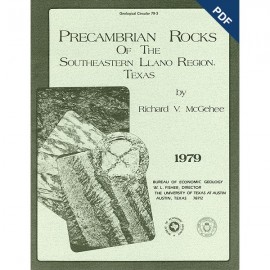Reports of Investigations
-
Books & Reports
- Reports of Investigations
- Guidebooks
- Udden Series
- Geological Circulars
- Down To Earth
- Atlases of Major Oil and Gas Reservoirs
- Texas Memorial Museum Publications
- Environmental Geologic Atlas of the Texas Coastal Zone
- Mineral Resource Circulars
- Other Reports
- Seminars and Workshops
- Handbooks
- Submerged Lands of Texas
- Symposia
- Annual Reports
- Open File Reports
-
Maps & Cross Sections
- Thematic Maps
- Miscellaneous Maps, Charts & Sections
- Geologic Atlas of Texas
- STATEMAP Project Maps
- Geologic Quadrangle Maps
- Cross Sections
- Highway Geology Map
- Energy and Mineral Resource Maps
- Shoreline Change and Other Posters
- Wilcox Group, East Texas, Geological / Hydrological Folios
- Bouguer Gravity Atlas of Texas
- River Basin Regional Studies
- Featured Maps
- Posters
- Teachers & the Public
-
Geological Society Publications
- Gulf Coast Association of Geological Societies
- Alabama Geological Society
- Austin Geological Society
- Corpus Christi Geological Society
- Houston Geological Society
- Lafayette Geological Society
- Mississippi Geological Society
- New Orleans Geological Society
- South Texas Geological Society
- GCS SEPM Publications
- Historic BEG & UT Series

Mineral Resources of the Colorado River Industrial Development Association Area. Digital Download
RI0037D
A free, digital version of this publication can be found on: Texas ScholarWorks
To purchase a print version (if available): RI0037
RI0037D. Mineral Resources of the Colorado River Industrial Development Association Area, by J. W. Dietrich and J. T. Lonsdale. 84 p., 22 figs., 9 plates, 1958. doi.org/10.23867/RI0037D. RI0037D - Downloadable PDF.
To purchase this publication in book format, please order RI0037.
ABSTRACT
The Colorado River Industrial Development Association area consists of ten counties [Bastrop, Blanco, Burnet, Colorado, Fayette, Llano, Matagorda, San Saba, Travis, and Wharton counties] in the lower watershed of Colorado River in Texas. The rocks exposed in the upriver part of the area include Precambrian metamorphic and igneous rocks and Paleozoic and Lower Cretaceous sedimentary rocks. In the Austin region Upper Cretaceous sedimentary rocks are exposed. In the downstream part of the area the rocks are of Tertiary and Quaternary ages. The principal mineral resource materials are industrial rocks and minerals. In the part of the area from Austin upstream, the most important materials are building stone, chemical limestone and dolomite, cement materials, graphite, soapstone, serpentine, vermiculite, and iron ore. From Austin downstream, the most important materials are sand and gravel, bleaching clay, burning clay, lignite, salt, sulfur, and oyster shell. There are small or low-grade deposits of many other materials, especially in the upriver region.
Keywords: minerals, mineral resources, Colorado River area, Texas
Citation
Dietrich, J. W., and Lonsdale, J. T., 1957, Mineral Resources of the Colorado River Industrial Development Association Area: The University of Texas at Austin, Bureau of Economic Geology, Report of Investigations No. 37, 84 p.




